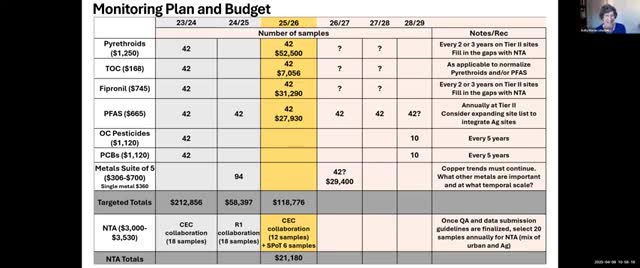Experts examine PFAS impacts from agricultural practices in California
April 26, 2025 | California Water Quality Monitoring Council, Boards and Commissions, Executive, California
This article was created by AI summarizing key points discussed. AI makes mistakes, so for full details and context, please refer to the video of the full meeting. Please report any errors so we can fix them. Report an error »

In a recent meeting of the California Water Quality Monitoring Council, experts gathered to discuss pressing issues surrounding water quality and the impact of agricultural practices on environmental health. The atmosphere was charged with a sense of urgency as participants shared insights on the presence of harmful substances in water systems, particularly focusing on the controversial PFAS compounds.
As the meeting unfolded, one participant recounted a troubling anecdote about the effects of common pesticides like diazinon and chlorpyrifos. These chemicals, they noted, could lead to sewage treatment plants falling out of compliance, especially when pet owners washed their dogs in nearby waters. This sparked a broader conversation about the need for comprehensive monitoring of water quality, particularly in areas where recreational activities intersect with agricultural runoff.
The discussion quickly turned to the role of the U.S. Geological Survey (USGS) in analyzing watershed contributions from wastewater treatment plants. Experts emphasized the importance of utilizing Geographic Information Systems (GIS) to map and understand these contributions effectively. The conversation highlighted the necessity of collaboration among agencies to enhance data collection and analysis, particularly regarding the presence of PFAS in agricultural settings.
Participants expressed concern over the lack of monitoring in agricultural areas, where PFAS could be introduced through various means, including pesticide formulations and the use of plastic mulch. One speaker pointed out that shifts in agricultural practices, such as moving from plastic to paper mulch, could inadvertently introduce PFAS into the environment. This revelation underscored the complexity of the issue and the need for targeted studies to understand the sources and impacts of these substances.
As the meeting progressed, the group discussed ongoing efforts to monitor PFAS levels at agricultural sites. There was a consensus that while initial studies had begun, more comprehensive data collection was essential to draw meaningful trends and relationships. The urgency of this task was palpable, as participants recognized that ignoring agricultural inputs could lead to significant gaps in understanding the broader implications for water quality.
In conclusion, the meeting served as a critical platform for addressing the intricate relationship between agricultural practices and water quality. As experts continue to navigate the challenges posed by PFAS and other contaminants, the call for enhanced monitoring and collaboration remains a priority. The discussions not only shed light on immediate concerns but also set the stage for future initiatives aimed at safeguarding California's water resources.
As the meeting unfolded, one participant recounted a troubling anecdote about the effects of common pesticides like diazinon and chlorpyrifos. These chemicals, they noted, could lead to sewage treatment plants falling out of compliance, especially when pet owners washed their dogs in nearby waters. This sparked a broader conversation about the need for comprehensive monitoring of water quality, particularly in areas where recreational activities intersect with agricultural runoff.
The discussion quickly turned to the role of the U.S. Geological Survey (USGS) in analyzing watershed contributions from wastewater treatment plants. Experts emphasized the importance of utilizing Geographic Information Systems (GIS) to map and understand these contributions effectively. The conversation highlighted the necessity of collaboration among agencies to enhance data collection and analysis, particularly regarding the presence of PFAS in agricultural settings.
Participants expressed concern over the lack of monitoring in agricultural areas, where PFAS could be introduced through various means, including pesticide formulations and the use of plastic mulch. One speaker pointed out that shifts in agricultural practices, such as moving from plastic to paper mulch, could inadvertently introduce PFAS into the environment. This revelation underscored the complexity of the issue and the need for targeted studies to understand the sources and impacts of these substances.
As the meeting progressed, the group discussed ongoing efforts to monitor PFAS levels at agricultural sites. There was a consensus that while initial studies had begun, more comprehensive data collection was essential to draw meaningful trends and relationships. The urgency of this task was palpable, as participants recognized that ignoring agricultural inputs could lead to significant gaps in understanding the broader implications for water quality.
In conclusion, the meeting served as a critical platform for addressing the intricate relationship between agricultural practices and water quality. As experts continue to navigate the challenges posed by PFAS and other contaminants, the call for enhanced monitoring and collaboration remains a priority. The discussions not only shed light on immediate concerns but also set the stage for future initiatives aimed at safeguarding California's water resources.
View full meeting
This article is based on a recent meeting—watch the full video and explore the complete transcript for deeper insights into the discussion.
View full meeting
